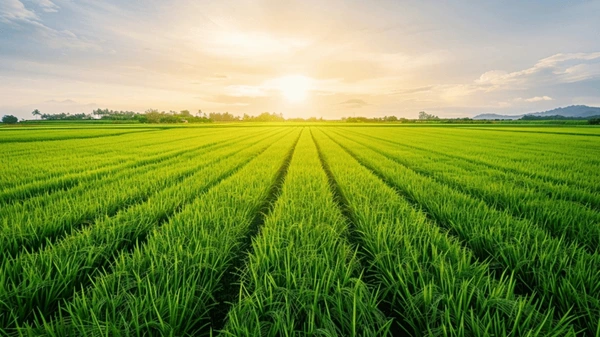
Image Source: Shutterstock
India’s mission to double farmers’ incomes is entering a pivotal execution phase, as the Ministry of Agriculture & Farmers Welfare reaffirms its commitment to structural transformation through policy innovation, expanded fiscal allocations, and digital modernization. Initiated in 2016 with the formation of an inter-ministerial committee, the goal of doubling income is anchored in a multi-dimensional strategy targeting productivity, diversification, efficiency, and market resilience.
The government has identified seven critical levers to drive income growth: Raising both crop and livestock productivity, improving resource-use efficiency through cost reduction, increasing cropping intensity, shifting to high-value agriculture, ensuring remunerative prices for produce, and transitioning surplus farm labor into non-farm opportunities. With this roadmap in place, the central government is working closely with states by aligning policy measures and expanding budgetary support. The Department of Agriculture & Farmers Welfare’s budget has surged nearly six-fold—from Rs 21,933 crore in 2013–14 to Rs 1,27,290 crore in 2025–26—signaling the seriousness of intent and scale.
A defining pillar of the income enhancement framework is the robust Minimum Support Price (MSP) regime. Since 2018–19, the government has maintained a pre-announced principle of fixing MSPs at least 1.5 times the all-India average cost of production, as recommended by the Commission for Agricultural Costs and Prices. To strengthen this system and mitigate market volatility, the government has rolled out an integrated scheme—Pradhan Mantri Annadata Aay Sanrakshan Abhiyan (PM-AASHA). The scheme comprises the Price Support Scheme (PSS), Price Deficiency Payment Scheme (PDPS), and the Market Intervention Scheme (MIS), each designed to ensure that farmers receive fair value for their produce without suffering distress sales.
Under the PSS, the Centre approves procurement of pulses, oilseeds, and copra up to 25 per cent of a State’s production during periods when market prices fall below MSP. States can even procure up to 25 percent of national production, subject to performance. In a strategic departure from previous norms, the government has allowed procurement of Tur, Urad, and Masur at 100 per cent of estimated State production until 2028–29 to reduce import dependency and incentivize domestic output.
The PDPS, on the other hand, offers direct payment of the price gap between MSP and market rates to registered farmers, covering up to 40 per cent of oilseed production, within specified market conditions. Meanwhile, the MIS brings stability to the horticulture sector, offering both procurement and price compensation mechanisms for perishable crops like tomato, onion, and potato. Together, these schemes establish a comprehensive price security architecture for India’s agricultural sector.
The income strategy also rests on modernization and precision. Precision agriculture has been recognized as a game-changer for input optimization, sustainable yield growth, and water efficiency. Through the Mission for Integrated Development of Horticulture (MIDH), the government is supporting the establishment of Centres of Excellence to showcase cutting-edge technologies in irrigation, crop monitoring, and fertigation—developed in partnership with Indian research institutes and foreign collaborators.
To digitally empower farmers and bring intelligence into every acre, the government is accelerating the Digital Agriculture Mission. Central to this is the creation of digital public infrastructure such as the AgriStack, Krishi Decision Support System, and geospatial soil fertility maps. AgriStack itself includes three core registries: a Farmers’ Registry, geo-referenced village maps, and a Crop Sown Registry—all maintained at the state level to ensure data fidelity. This data backbone supports precision advisory systems and fosters the development of farmer-centric digital solutions powered by AI, machine learning, IoT, and blockchain. Under the National e-Governance Plan in Agriculture (NeGPA), states are receiving targeted support to scale such technologies across the field.
Post-harvest losses—often responsible for 20 to 30 percent of value erosion—are being directly addressed through infrastructure investment. The Agriculture Infrastructure Fund (AIF) has so far sanctioned 2,454 cold storage projects with a total outlay of Rs 8,258 crore. These facilities, often integrated with grading and packaging units, are being developed by farmer cooperatives, SHGs, entrepreneurs, and APMCs across key agri-export and production clusters. Under the MIDH, subsidies of 35 to 50 per cent are offered to eligible units in general, hilly, or scheduled areas, supporting pack houses, ripening chambers, reefer transport, and other components critical to value retention.
Interestingly, while countries like the Netherlands and Israel are often cited as benchmarks in agricultural innovation, the Indian government currently has no formal proposal to replicate such high-tech models in metropolitan zones. Instead, the focus remains on scaling decentralized, inclusive agricultural transformation within the national context—balancing self-sufficiency in food grains with climate-resilient innovation.
India’s farm income strategy is a layered, long-term play—where price assurance, market connectivity, precision technologies, and infrastructure finance converge into a cohesive platform. As fiscal support accelerates and institutional mechanisms deepen, the goal of doubling farmers’ incomes is transitioning from aspirational to executable.